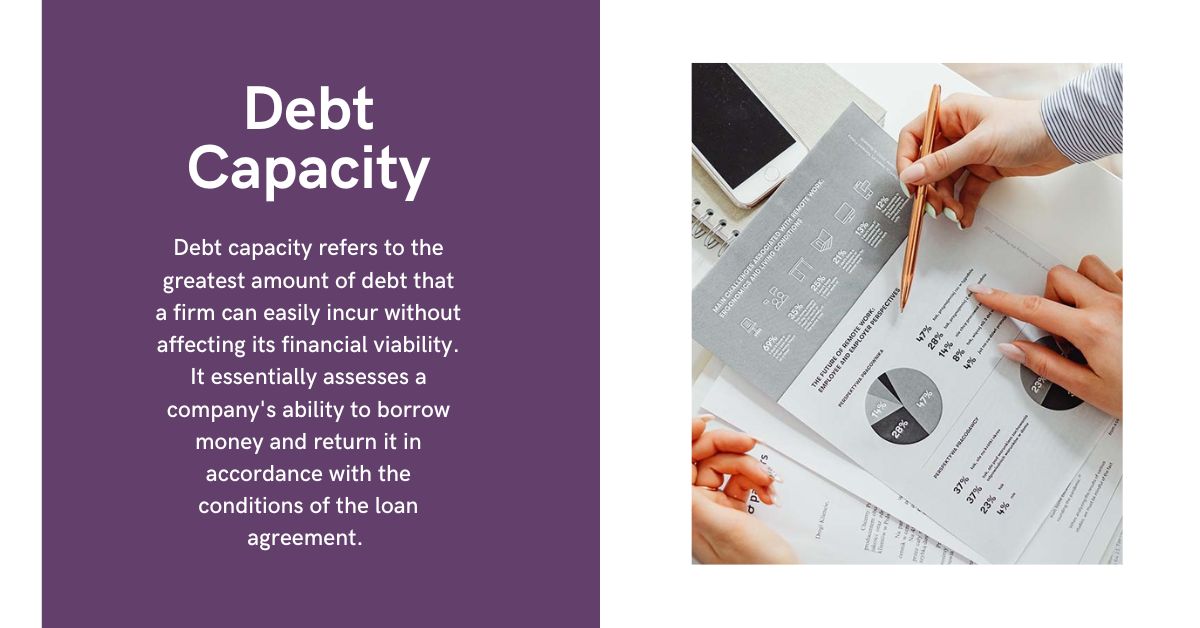With a tight schedule and several initiatives on your plate, obtaining financial guidance to determine whether expansion or acquisition is possible can be more challenging than you might expect. Obtaining a definitive answer entails gathering financial information, existing responsibilities, and submitting applications to several lending organizations. The time and effort required can often jeopardize a business or opportunity.
Business executives must be continually aware of how their company’s financial performance and market fluctuations effect debt capacity, which is the best indicator of your company’s ability to borrow.
What is Debt Capacity?

Debt capacity refers to the greatest amount of debt that a firm can easily incur without affecting its financial viability. It essentially assesses a company’s ability to borrow money and return it in accordance with the conditions of the loan agreement. Factors influencing this capability include the company’s revenue, profitability, cash flow, assets, and general financial health.
A corporation with a high debt capacity can use debt to fund growth activities, including expanding operations, acquiring new businesses, or investing in R&D. However, taking on too much debt can cause financial difficulty and possibly bankruptcy. Therefore, recognizing and managing debt capacity is critical for any firm.
Calculation of Debt Capacity
Calculating debt capacity is a complex process that involves analyzing various financial metrics and considering the specific circumstances of a company. While there’s no single formula that can provide a definitive answer, several key factors are typically taken into account:
1. Debt-to-Equity Ratio:
- Measures the proportion of debt to equity financing.
- A higher ratio indicates a higher level of leverage, which can increase financial risk.
- Generally, a lower debt-to-equity ratio suggests better debt capacity.
2. Interest Coverage Ratio:
- Measures a company’s ability to cover its interest expenses with its earnings before interest and taxes (EBIT).
- A higher ratio indicates a stronger ability to service debt.
- A ratio of 2 or higher is often considered a healthy benchmark.
Want to read more about Interest Coverage Ratio? You can read here:
3. Cash Flow Coverage Ratio:
- Measures the ratio of operating cash flow to debt service costs.
- A higher ratio suggests a stronger ability to meet debt obligations.
4. Leverage ratios:
- Other leverage ratios, such as debt-to-assets ratio or debt-to-capital ratio, can also provide insights into a company’s debt capacity.
5. Industry Benchmarks:
- Comparing a company’s debt ratios to industry averages can help assess its relative debt capacity.
6. Qualitative factors:
- Business Model: The stability and predictability of a company’s revenue stream can influence its debt capacity.
- Competitive Position: A strong market position and competitive advantage can support higher debt levels.
- Management Team: The experience and competence of a company’s management team can impact its ability to manage debt.
- Economic Outlook: The overall economic environment can affect a company’s ability to generate revenue and repay debt.
It is vital to understand that debt capacity is not a fixed figure. It can fluctuate over time due to changes in business conditions, interest rates, and the company’s own financial performance. As a result, constant monitoring and reassessment of debt capacity is critical for ensuring financial stability.
How Do Lenders Analyze Credit Risk?
Lenders assess credit risk by determining the borrower’s ability and willingness to repay a loan. They examine a number of factors, including:
- Credit History: A borrower’s payment history on loans and credit cards is an important measure of their creditworthiness.
- Income and Debt: Lenders assess a borrower’s income to estimate their ability to pay and compare it to their current debt obligations.
- A credit score is a numerical representation of a borrower’s creditworthiness that takes into account characteristics such as payment history, credit use, and credit history duration.
- Collateral: If a loan has collateral as security, lenders evaluate the asset’s value to determine whether it would be able to repay the loan in the event of default.
- Debt-to-Income Ratio: This ratio compares a borrower’s debt obligations to their income. A lower ratio typically suggests a greater ability to manage debt.
- Lenders may examine a borrower’s character, which includes their employment experience, education, and personal references, when determining their overall reliability.
By examining these indicators, lenders can make informed decisions about a borrower’s chances of repaying a loan, as well as the proper conditions and interest rates.
How Does Leverage Risk Affect Debt Capacity?
Leverage risk has an important effect on a company’s debt capacity. When a corporation uses debt to fund its operations, it increases its leverage, which can magnify both profits and losses. A higher amount of debt can boost returns during good economic times, but it can also cause severe financial distress during downturns.
A corporation that has a high debt-to-equity ratio may be classified as highly leveraged. This can make it difficult to get more financing since lenders may view the company as having a larger risk of default. Furthermore, a heavily leveraged corporation may be more vulnerable to interest rate changes and economic downturns.
Therefore, knowing and controlling leverage risk is critical for preserving debt capacity. Companies must carefully analyze their ability to service debt obligations and avoid undue leverage in order to maintain financial stability.
What is the Meaning of Debt Carrying Capacity?
Debt carrying capacity is a company’s ability to manage and service its existing debt obligations without financial stress or default. It is effectively the highest amount of debt that a corporation can reasonably bear depending on its present financial performance, cash flow, and overall financial health.
What is the Debt Coverage Capacity?
Debt coverage capability is a financial indicator that assesses a company’s ability to generate enough cash flow to cover its debt service payments, which include principal and interest. It is a critical measure of a company’s financial health and capacity to satisfy debt obligations.
A high debt coverage capacity indicates that a corporation has enough cash flow to service its debt, which lowers the chance of default. Conversely, poor debt coverage capacity suggests that a corporation may struggle to satisfy its debt commitments, perhaps resulting in financial issues.
Debt coverage capacity is usually determined by dividing a company’s operating cash flow by its total debt service payments. A ratio of 1 or higher implies that the company generates adequate cash to meet its debt obligations.
What is the Net Debt Capacity?
Net debt capacity is a financial indicator that assesses a company’s ability to incur extra debt while maintaining its financial health. It is calculated by deducting a company’s cash and cash equivalents from its overall debt.
A positive net debt capacity shows that a corporation has more debt than cash, implying that it may have limited ability to incur new debt. whereas a negative net debt capacity shows that a corporation has more cash than debt, implying that it has the financial flexibility to incur extra debt if necessary.
Net debt capacity is frequently used in conjunction with other financial indicators, such as debt-to-equity ratio, interest coverage ratio, and cash flow coverage ratio, to evaluate a company’s overall financial health and debt management capability.

